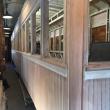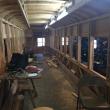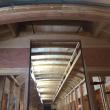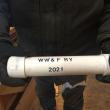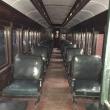Coach No. 9: A beauty in the making
 The replica coach #9 at WW&F in Alna out of the shop for the first time, bound for the Sheepscot yard and Bay 4 for interior work. Courtesy of WW&F Railway
The replica coach #9 at WW&F in Alna out of the shop for the first time, bound for the Sheepscot yard and Bay 4 for interior work. Courtesy of WW&F Railway
 Master carpenter and train buff Eric Schade inside a door frame of coach #9. LISA KRISTOFF/Boothbay Register
Master carpenter and train buff Eric Schade inside a door frame of coach #9. LISA KRISTOFF/Boothbay Register
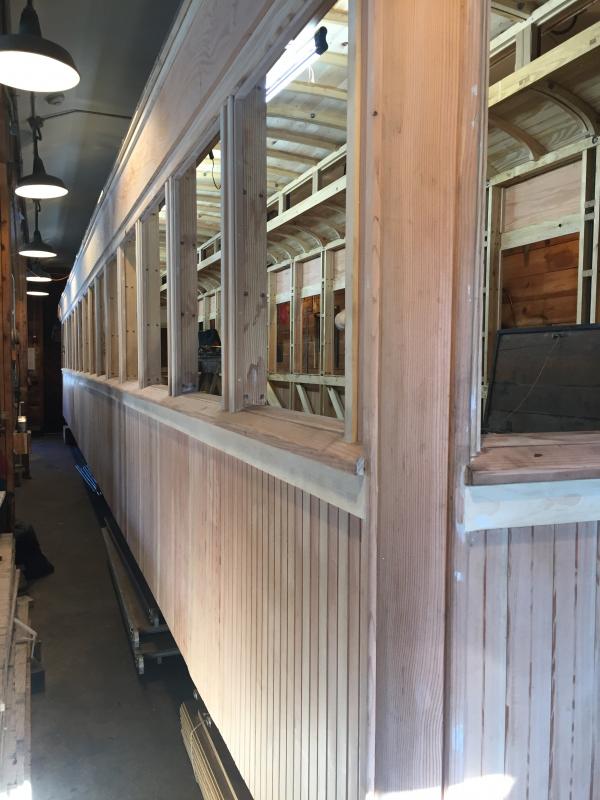 The beadboard outer walls. LISA KRISTOFF/Boothbay Register
The beadboard outer walls. LISA KRISTOFF/Boothbay Register
 Inside coach #9. LISA KRISTOFF/Boothbay Register
Inside coach #9. LISA KRISTOFF/Boothbay Register
 Engine 52 moving coach #9 on Jan. 12. Courtesy of WW&F Railway
Engine 52 moving coach #9 on Jan. 12. Courtesy of WW&F Railway
 LISA KRISTOFF/Boothbay Register
LISA KRISTOFF/Boothbay Register
 A sample of the decorative badge work in coach #3 that has been reproduced by Master Carpenter Eric Schade at WW&F Railway for coach #9. LISA KRISTOFF/Boothbay Register
A sample of the decorative badge work in coach #3 that has been reproduced by Master Carpenter Eric Schade at WW&F Railway for coach #9. LISA KRISTOFF/Boothbay Register
 Original coach #3 will receive some TLC after its replica is completed. LISA KRISTOFF/Boothbay Register
Original coach #3 will receive some TLC after its replica is completed. LISA KRISTOFF/Boothbay Register
 This time capsule will be filled with info about WW&F RR, the restoration process, and who knows what else. LISA KRISTOFF/Boothbay Register
This time capsule will be filled with info about WW&F RR, the restoration process, and who knows what else. LISA KRISTOFF/Boothbay Register
 Volunteers signatures on the wall ... similar to the walls of the dressing rooms of Lincoln Theater with the names of every actor who performed there. LISA KRISTOFF/Boothbay Register
Volunteers signatures on the wall ... similar to the walls of the dressing rooms of Lincoln Theater with the names of every actor who performed there. LISA KRISTOFF/Boothbay Register
 The seats in coach #9 will be covered in light green velour, not leather like the original 1894 coach #3. LISA KRISTOFF/Boothbay Register
The seats in coach #9 will be covered in light green velour, not leather like the original 1894 coach #3. LISA KRISTOFF/Boothbay Register
 The cast iron seat frames in replica coach #9 will look like this one in coach #3.
The cast iron seat frames in replica coach #9 will look like this one in coach #3.
 The replica coach #9 at WW&F in Alna out of the shop for the first time, bound for the Sheepscot yard and Bay 4 for interior work. Courtesy of WW&F Railway
The replica coach #9 at WW&F in Alna out of the shop for the first time, bound for the Sheepscot yard and Bay 4 for interior work. Courtesy of WW&F Railway
 Master carpenter and train buff Eric Schade inside a door frame of coach #9. LISA KRISTOFF/Boothbay Register
Master carpenter and train buff Eric Schade inside a door frame of coach #9. LISA KRISTOFF/Boothbay Register
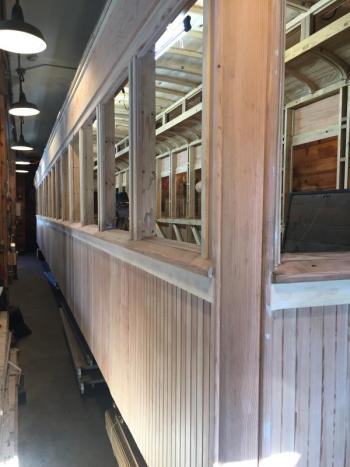 The beadboard outer walls. LISA KRISTOFF/Boothbay Register
The beadboard outer walls. LISA KRISTOFF/Boothbay Register
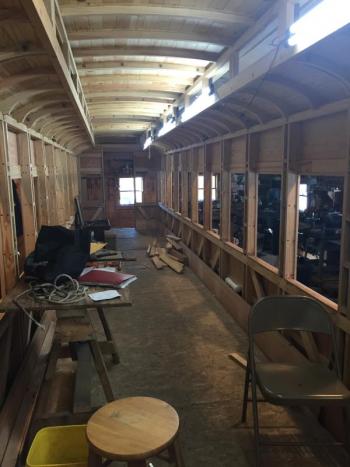 Inside coach #9. LISA KRISTOFF/Boothbay Register
Inside coach #9. LISA KRISTOFF/Boothbay Register
 Engine 52 moving coach #9 on Jan. 12. Courtesy of WW&F Railway
Engine 52 moving coach #9 on Jan. 12. Courtesy of WW&F Railway
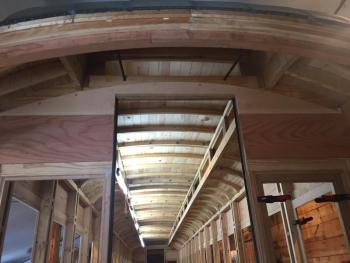 LISA KRISTOFF/Boothbay Register
LISA KRISTOFF/Boothbay Register
 A sample of the decorative badge work in coach #3 that has been reproduced by Master Carpenter Eric Schade at WW&F Railway for coach #9. LISA KRISTOFF/Boothbay Register
A sample of the decorative badge work in coach #3 that has been reproduced by Master Carpenter Eric Schade at WW&F Railway for coach #9. LISA KRISTOFF/Boothbay Register
 Original coach #3 will receive some TLC after its replica is completed. LISA KRISTOFF/Boothbay Register
Original coach #3 will receive some TLC after its replica is completed. LISA KRISTOFF/Boothbay Register
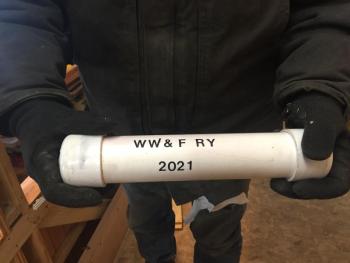 This time capsule will be filled with info about WW&F RR, the restoration process, and who knows what else. LISA KRISTOFF/Boothbay Register
This time capsule will be filled with info about WW&F RR, the restoration process, and who knows what else. LISA KRISTOFF/Boothbay Register
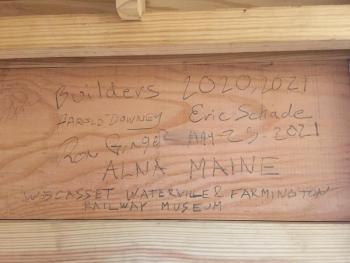 Volunteers signatures on the wall ... similar to the walls of the dressing rooms of Lincoln Theater with the names of every actor who performed there. LISA KRISTOFF/Boothbay Register
Volunteers signatures on the wall ... similar to the walls of the dressing rooms of Lincoln Theater with the names of every actor who performed there. LISA KRISTOFF/Boothbay Register
 The seats in coach #9 will be covered in light green velour, not leather like the original 1894 coach #3. LISA KRISTOFF/Boothbay Register
The seats in coach #9 will be covered in light green velour, not leather like the original 1894 coach #3. LISA KRISTOFF/Boothbay Register
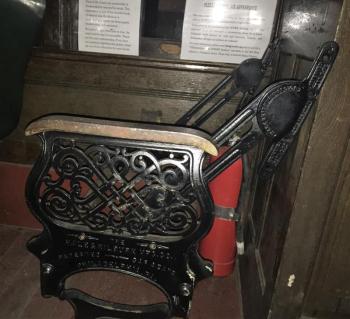 The cast iron seat frames in replica coach #9 will look like this one in coach #3.
The cast iron seat frames in replica coach #9 will look like this one in coach #3.
There’s always a whole lot of work going on behind the scenes at Alna’s Wiscasset, Waterville & Farmington Railway Museum, but over the past two years a replica of coach #3 has been taking shape. The idea arose five years ago and continued building steam. WW&F Master Carpenter Eric Schade noted the railway never has enough seats for guests, whether it’s for the Christmas trains or other events.
Thanks to a couple’s 2016 donation, construction of a new coach was made possible. The donation specified construction was to be from scratch. When the coach is completed, it will get cosmetic and other attention.
Construction of the replica, called Coach #9, began in January 2020 following a few years of studying the original, built in 1894 by Jackson & Sharp in Wilmington, Delaware. Number 3 journeyed from Delaware to Bridgton & Saco River Railroad in 1909 until the railroad went out of business; to Edaville Railroad in Massachusetts three years later until it went out of business; to Maine Narrow Gauge Railroad in Portland, and then to WW&F.
Before the replica frame was started, a new concrete floor was poured in the original sections of workshop bays 2 and 3. Schade popped off the beadboard on the outside of Coach 3 to study how it was installed. “I took hundreds of pictures before we started,” Schade said. And not just of that exterior. There are photos documenting every stage of the restoration.
Schade and volunteers Harold Downey of Texas and Maine, Ron Ginger, Lou Gross and Randy Beach could be called the core of the coach replica team. Downey has been completing a lot of work from Texas including working on the patterns for the black cast iron seat frames sent to Cattail Foundry in Pennsylvania to be cast. Downey cut the framing in his shop in Texas, shipped the completed sets to Sheepscot and built the oak window frames and doors for the coach.
In addition to oak, Coach #9 is constructed of Texas yellow pine and clean Douglas fir from Viking Lumber in Belfast.
The 30 rectangular clerestory windows in the original car are frosted glass. Coach #9’s are textured, dark amber glass. Coach #9 will have the same graceful curves above the clerestory windows; panels will have decorative lines, filigree, and carved badges. Three sets of double chandeliers will hang from the ceiling. The chandeliers are coming from a company specializing in replica lighting. And the 28-30 seats in two rows along the sides of the car will be covered in light green velour fabric rather than the leather used in the original coach.
Safety glass, made to look old-fashioned, will be used for the seat windows. Schade said they determined the only original window in the 1897 coach was one in the bathroom, which was the one they based the windows for coach #9 on.
The metal roofing was installed by Schade and Randy Beach and completed in early January. Schade and Ginger will be working on the interior woodwork shortly, and there are all those fittings to be made.
A time capsule, with information about WW&F and with other undetermined goodies, will be placed inside one of the interior walls below the windows.
“I wouldn’t put a date on when we will be finished,” said Schade. “Maybe in a few years. We have a lot of finishing work to be done.”
Coach #9 isn’t the only construction going on at the local landmark. There’s the new engine house, Boxcar 67 has had some sprucing up and new paint, Boxcar 56 is being rebuilt, Engine 11 is having some new parts fashioned, and Engine 7 is being reconstructed.
For museum happenings, visit Facebook: https://www.facebook.com/WWFRailway or https://www.wwfry.org















